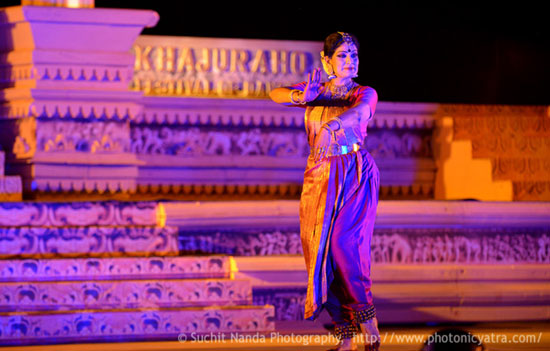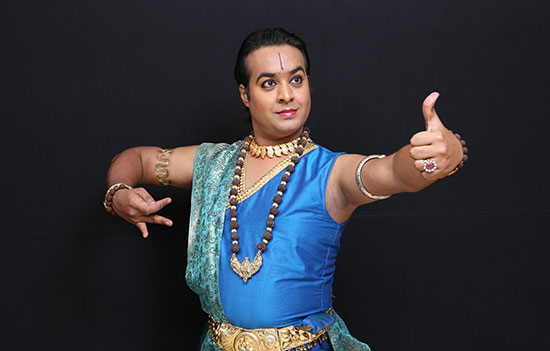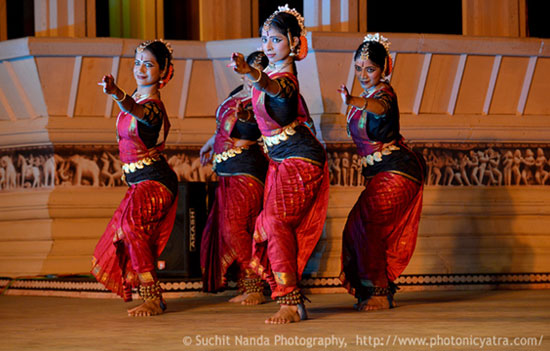- A brief background on the origin, development of about Bharatanatyam dance
form of India.
Classical dance
as we know them today, may be said to have evolved from the folk dances
prevalent that are even today part of our rural and tribal dances. Folk
dances are performed with joyous abandon on occasions such as a harvest, festival
or marriage. Tribal dances are part of the community.
Also read Folk
dance forms of Odisha
However,
classical dance is a highly sophisticated, complex and complete art form i.e. different
from folk or tribal dance. Let alone understanding it fully, even to enjoy and
appreciate it, requires a certain level of understanding and refinement.
Also read
Significance
of Hasta Mudras in Indian Classical Dance
Ghoomar,
an elegant dance form of Rajasthan
Kalbelia
dance Rajasthan gets you to dance
Folk
dances of Assam
Our
country is unique, as we have eight distinct classical dance styles, like
Bharata Natyam from Tamil Nadu, Kathakali and Mohiniattam from Kerala,
Kuchipudi from Andhra Pradesh, Odissi from Orissa, Sattriya from Assam,
Manipuri from Manipur and Kathak from north India. Undoubtedly Bharata natyam
holds the supreme position of being the most popular classical dance, enjoying
international recognition, particularly in European countries.
Also read About
Sitara Devi, noted Kathak dancer
Bharata Natyam is the oldest classical dance of style, with a history i.e. more
than five thousand years old. This dance form is internationally acclaimed too.
It is a pleasure to watch young children learn it in New York, London or
Zurich.
 Youth in New York getting ready to perform on Diwali. Pic Hinduism Today.
Youth in New York getting ready to perform on Diwali. Pic Hinduism Today.
Also read Bharatya
Natyam in Canada and A
Shining Peruvian Bharatanatyam Dancer
Evolution
Architectural
and sculptural evidence prove that Bharata Natyam and some other classical
dance styles like Odissi and Manipuri originated from temples. The earliest
reference is in the second century Tamil classic Silappadikaram. The temples that developed during the sixth to
ninth century signify and define dance as a well refined art form.
Also read Bharata’s Natya Sastra
Varied
aspects of music and dance was derived from the four Vedas namely Rig, Yajur,
Atharva and Sam. The fifth Veda known as Natya Veda was created by Lord Brahma.
Lord
Nataraja (Shiva) is the king of dance and all classical dance styles portray
stories from Indian tradition. Unfortunately, stories from the Holy Bible are
also recreated in the dance format.
The eight types of classical dance styles are based on texts like Bharatas Natya Sastra, Nandikesvaroa's Abhinaya Darpana, Sangita Ratnakara etc. Stories are revealed through the medium of varied intricate movements, body language and expressional dancing in order to establish the inter-relationship between the human and divine soul.
Devadasis or servants of the Lord
During
the eighteen and nineteen centuries when the devadasi system prevailed, young
teenage girls were married to the Lord as part of the temple ritual. The girls
were trained in classical music and dance and performed on religious and social
occasions.
Then,
Bharata Natyam then was also known as devadasi attam or sadir. The degradation of classical dance started when devadasis moved on from the temple courtyards to dance for elite chieftains and zamindars and ultimately for kings, thus enjoyed royal patronage.
While
the dancers were blamed and ostracized by society the society is equally
responsible for the shift of focus from the spirit to the body. The British
banned the devadasi system and the described the dancers as nautch girls. There were protests since
the sanctity of classical dance was disturbed and dances were witnessed only in
closed quarters.
Classical
dances went through varied stages of progression and regression due to varied
social and political changes over the centuries. During the 20th century, American dancer Esther Sherman changed her name to Ragini Devi in order to learn classical dance. So also, lawyer and critic E Krishna Iyer donned female attire to attract children from respectable families to learn classical dance.
Theosophist
and founder of the Kalashetra School in Chennai, Dr
Rukmini Devi Arundale (awarded Padma Bhushan in 1956) and the legendary
dancer from the devadasi community, Balasaraswati,
are considered pioneers of the dance movement in India.
 Geeta Chandran, founder President Natya Vriksha, at Khajuraho Dance Festival 2014.
Geeta Chandran, founder President Natya Vriksha, at Khajuraho Dance Festival 2014.
Also read
The
lady who chose Dance over becoming President of India
How
a gritty girl from TN took Bharatanatyam to the world
Ram Gopal and Uday Shankar placed classical dances on the international
platform. Great poets like Tagore and Vallthol promoted classical dance that
helped regain its respectability.
Music and technique
The music is in the classical Carnatic music style and trinity of Carnatic music namely Tygaraja, Shyama Sastri and Muthuswami Dikshitar are the composers whose compositions form the main repertoire of any Bharata Natyam performance. Compositions of saint poets like Sankaracharya, Meerabai and Tulsidas amongst others are also being used in Bharatnatyam, particularly by the Maratha rulers of Thanjavur.
Also read Thyagaraja,
musician par excellence &Thyagaraja
Temple, Tirvuvarur
The technique of Bharata Natyam is quite intricate and complex.
Bha is Bhavam (expressions), Ra
is Ragam (musical melody) musical melody, Ta is Talam (time measure or rhythm) and Natyam is dramatic quality. Furthermore, Bharata Natyam is a beautiful and divine art form that combines music, melody, histrionics, philosophy, psychology, mythology, varied movements etc. Students start learning at the tender age of five and the minimum learning is of at least ten years. During learning period various movements and steps (adavus) are taught that becomes quite intricate. Later all the movements and gestures are used in a particular item or number.
On completion
of training the student performs the Arangetram
(ascending of the stage). The performance begins with invocations and prayers to the gods Todaya mangalam, pushpanjali, alarippu, jatiswaram, sabdam varnam, padam and the finale thillana. (Todaya Mangalam
is a dance of invocation, presented at the beginning of the performance, in
praise of Lord Ganesha, the remover of obstacles, the trinity of Indian
classical dance and other gods for the blessings and success of the performance).
 Pic by Nilesh Singha.
Pic by Nilesh Singha.
The
celebrated Tanjavur brothers designed the repertoire for the margam of
Bharata natyam. Their contribution becomes relevant from the point of view of
history.
The dance Compositions of the
Tanjore Quartet edited
by Sivanandam, reveals the years of these famous brothers i.e. Chinnaya,
Ponnaiyya, Sivanandam and Vadivelu. They were responsible for
reshaping the art of Bharata Natyam into a stylized concert format and also
helped in classifying the basic Adavus
(steps) for teaching purposes. The present patterns for presentation are
aesthetically pleasing as it starts with slight body movements to the difficult
Jathi Korvais, then Abhinaya numbers. It ultimately culminating
into the joyous finale Thillana.
One must have the literary value of life in order to present the dance form as a poem as it would run through the pages. A poem has to be analysed from all angles and so also the poet's time of birth and death, as that would throw light on the cultural, political and social background of the place.
 Pic by Nilesh Singha.
Pic by Nilesh Singha.
Keeping this view in mind, one cannot reject different styles or schools of Bharata natyam like Pandanallur, Thanjavur, Kancheepuram or Vazhuvoor as sub styles. Of course one cannot claim authenticity or superiority of any style except that few styles came into vogue during the revivalistic period. (The revival period commenced with poet Vallathol as he established Kerala Kalamandalam in Kerala in 1930. Simultaneously, Rabindranath Tagore established Shanti Niketan in Kolkata, which is considered the abode of both arts and literature. Further, fine arts received a new impetus from other personalities, like sage Siddhendra Yogi, promoting and propagating classical dance and music).
 Vaibhav Arekar & troupe. Khajuraho Dance Festival 2014.
Vaibhav Arekar & troupe. Khajuraho Dance Festival 2014.
Top Dancers and Conclusion
Some of
the top dancers are Mrinalini Sarabhai, Yamini Krishnamurthy, Padma
Subrahmanyam, Chitra Visweswaran,Sudharani Raghupathy, Malvika Sarukkai, Deepak
Mazumdar, Alarmel Valli, Padmaja Suresh, Mamatha Karanth, Srekala Bharath and
young dancers like. Vaibhav Arekar, Parshvanath Upadhye,Nilesh Singha, Pavitra
Bhat, Namita Bodaji ,etc.
To pursue
a career in classical dance and become a fine performer is not easy. One needs lots
of patience, determination, will power and hard work. It is a consistent
process of growth, mentally, physically and spiritually.
Classical
dance is the expression of the soul, far beyond the physical and tangible
world.
Guru Vijay Shanker is a professional Kuchipudi, Kathakali exponent, dance teacher, choreographer, actor and arts critic for over four decades, contributing for national and international publications. He is particularly credited for his lecture-demonstrations on Indian classical dancing which is a fine combination of both education and entertainment.
To read all articles on
Dance
To
read all articles by author
Also read
1. Hindu
feminine under colonial morality